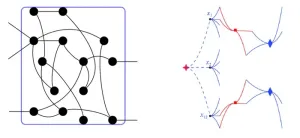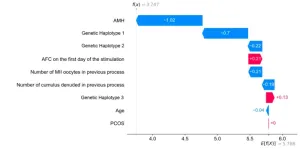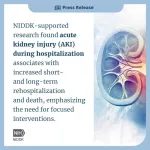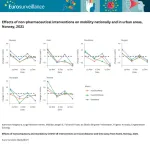(Press-News.org) Solving a riddle that has confounded biologists since bacterial spores — inert, sleeping bacteria — were first described more than 150 years ago, researchers at Harvard Medical School have discovered a new kind of cellular sensor that allows spores to detect the presence of nutrients in their environment and quickly spring back to life.
It turns out that these sensors double as channels through the membrane and remain closed during dormancy but rapidly open when they detect nutrients. Once open, the channels allow electrically charged ions to flow out through the cell membrane, setting in motion the shedding of protective spore layers and the switching on of metabolic processes after years — or even centuries — of dormancy.
The team’s findings, published April 28 in Science, could help inform the design of ways to prevent dangerous bacterial spores from lying dormant for months, even years, before waking up again and causing outbreaks.
“This discovery solves a puzzle that’s more than a century old,” said study senior author David Rudner, professor of microbiology in the Blavatnik Institute at HMS. “How do bacteria sense changes in their environment and take action to break out of dormancy when their systems are almost completely shut down inside a protective casing?”
How sleeping bacteria come back to life
To survive adverse environmental conditions, some bacteria go into dormancy and become spores, with biological processes put on hold and layers of protective armor around the cell.
These biologically inert mini fortresses allow bacteria to wait out periods of famine and shield themselves from the ravages of extreme heat, dry spells, UV radiation, harsh chemicals, and antibiotics.
For more than a century, scientists have known that when the spores detect nutrients in their environment, they rapidly shed their protective layers and reignite their metabolic engines. Although the sensor that enables them to detect nutrients was discovered almost 50 years ago, the means of delivering the wake-up signal, and how that signal triggers bacterial revival remained a mystery.
In most cases, signaling relies on metabolic activity and often involves genes encoding proteins to make specific signaling molecules. However, these processes are all shut off inside a dormant bacterium, raising the question of how the signal induces the sleeping bacteria to wake up.
In this study, Rudner and team discovered that the nutrient sensor itself assembles into a conduit that opens the cell back up for business. In response to nutrients, the conduit, a membrane channel, opens, allowing ions to escape from the spore interior. This initiates a cascade of reactions that allow the dormant cell to shed its protective armor and resume growth.
The scientists used multiple avenues to follow the twists and turns of the mystery. They deployed artificial intelligence tools to predict the structure of the intricately folded sensor complex, a structure made of five copies of the same sensor protein. They applied machine learning to identify interactions between subunits that make up the channel. They also used gene-editing techniques to induce bacteria to produce mutant sensors as a way to test how the computer-based predictions played out in living cells.
“The thing that I love about science is when you make a discovery and suddenly all these disparate observations that don’t make sense suddenly fall into place,” Rudner said. “It’s like you’re working on a puzzle, and you find where one piece goes and suddenly you can fit six more pieces very quickly.”
Rudner described the process of discovery in this case as a series of confounding observations that slowly took shape, thanks to a team of researchers with diverse perspectives working together synergistically.
Along the way, they kept making surprising observations that confused them, hints that suggested answers that didn’t seem like they could possibly be true.
Stitching the clues together
One early clue emerged when Yongqiang Gao, an HMS research fellow in the Rudner lab, was conducting a series of experiments with the microbe Bacillus subtilis, commonly found in soil and a cousin to the bacterium that causes anthrax. Gao introduced genes from other bacteria that form spores into B. subtilis to explore the idea that the mismatched proteins produced would interfere with germination. Much to his surprise, Gao found that in some cases the bacterial spores reawakened flawlessly with a set of proteins from a distantly related bacterium.
Lior Artzi, a postdoctoral fellow in the lab at the time of this research, came up with an explanation for Gao’s finding. What if the sensor was a kind of receptor that acts like a closed gate until it detects a signal, in this case a nutrient like a sugar or an amino acid? Once the sensor binds to the nutrient, the gate pops open, allowing ions to flow out of the spore.
In other words, the proteins from distantly related bacteria would not need to interact with mismatched B. subtilis spore proteins, but instead simply respond to changes in the electric state of the spore as ions begin to flow.
Rudner was initially skeptical of this hypothesis because the receptor didn’t fit the profile. It had almost none of the characteristics of an ion channel. But Artzi argued the sensor might be made up of multiple copies of the subunit working together in a more complex structure.
AI has entered the chat
Another postdoc, Jeremy Amon, an early adopter of AlphaFold, an AI tool that can predict the structure of proteins and protein complexes, was also studying spore germination and was primed to investigate the nutrient sensor.
The tool predicted that a particular receptor subunit assembles into a five-unit ring known as a pentamer. The predicted structure included a channel down the middle that could allow ions to pass through the spore’s membrane. The AI tool’s prediction was just what Artzi had suspected.
Gao, Artzi, and Amon then teamed up to test the AI-generated model. They worked closely with a third postdoc, Fernando Ramírez-Guadiana and the groups of Andrew Kruse, HMS professor of biological chemistry and molecular pharmacology, and computational biologist Deborah Marks, HMS associate professor of systems biology.
They engineered spores with altered receptor subunits predicted to widen the membrane channel and found the spores awoke in the absence of nutrient signals. On the flip side, they generated mutant subunits that they predicted would narrow the channel aperture. These spores failed to open the gate to release ions and awake from stasis in the presence of ample nutrients to coax them out of dormancy.
In other words, a slight deviation from the predicted configuration of the folded complex could leave the gate stuck open or shut, rendering it useless as a tool for waking up the dormant bacteria.
Implications for human health and food safety
Understanding how dormant bacteria spring back into life is not just an intellectually tantalizing puzzle, Rudner said, but one with important implications for human health. A number of bacteria that are capable of going into deep dormancy for stretches of time are dangerous, even deadly pathogens: The powdery white form of weaponized anthrax is a made up of bacterial spores.
Another dangerous spore-forming pathogen is Clostridioides difficile, which causes life-threatening diarrhea and colitis. Illness from C. difficile typically occurs after use of antibiotics that kill many intestinal bacteria but are useless against dormant spores. After treatment, C. difficile awakens from dormancy and can bloom, often with catastrophic consequences.
Eradicating spores is also a central challenge in food-processing plants because the dormant bacteria can resist sterilization due to their protective armor and dehydrated state. If sterilization is unsuccessful, germination and growth can cause serious foodborne illness and massive financial losses.
Understanding how spores sense nutrients and rapidly exit dormancy can enable researchers to develop ways to trigger germination early, making it possible to sterilize the bacteria, or block germination, keeping the bacteria trapped inside their protective shells, unable to grow, reproduce, and spoil food or cause disease.
Authorship, funding, disclosures
Additional authors include Kelly Brock and Joshua Cofsky, of HMS.
Support for this work comes from the National Institutes of Health grants GM086466, GM127399, GM122512, AI171308 (DZR), AI164647 (DZR, ACK, DSM) and funds from the Harvard Medical School Dean’s Initiative. Amon was funded by National Institutes of Health grant F32GM130003. Artzi was a Simons Foundation fellow of the Life Sciences Research Foundation.
Paper DOI: 10.1126/science.adg9829
END
How dormant bacteria come back to life
Research provides answers to long-standing mystery of bacterial spores, illuminating new paths for disease prevention
2023-04-27
ELSE PRESS RELEASES FROM THIS DATE:
Collaborative and creative policies needed to maximize psychedelics’ therapeutic potential
2023-04-27
HOUSTON – (April 27, 2023) – Research supports the promise of psychedelics in treating conditions like depression and post-traumatic stress disorder, but the future regulatory landscape for these drugs remains unclear. Experts from Baylor College of Medicine, the University of Pennsylvania, American University and Harvard Law School call for creativity and collaboration at the federal and state levels in developing policies for the use and oversight of psychedelics and a commitment to developing a strong evidence base for efficacy and safety.
In a paper published in the journal Science, the authors, experts in bioethics, law and ...
Fish’s growth is not reduced by spawning
2023-04-27
Contrary to what is stated in biology textbooks, the growth of fish doesn’t slow down when and because they start spawning. In fact, their growth accelerates after they reproduce, according to a new article published in Science.
“Fish don’t have to choose between growth or reproduction because, in the real world, they don’t occur simultaneously but rather sequentially,” says University of British Columbia (UBC) fisheries researcher Dr. Daniel Pauly, co-author of ...
Local holographic transformations: tractability and hardness
2023-04-27
Counting problems arise in many different fields, e.g., statistical physics, economics and machine learning. In order to study the complexity of counting problems, several natural frameworks have been proposed. Two well studied frameworks are counting constraint satisfaction problems (#CSP) and Holant problems. For counting satisfaction problems over the Boolean domain, two explicit tractable families namely and , are identified; any function set which is not contained in these two families is proved to be #P-hard. Furthermore, counting CSPd is the counting constraint satisfaction problem restricted to the instances where every variable occurs a multiple of d times. The team ...
IVF procedures can be improved by combining genetic and clinical data to predict the number of eggs retrieved in patients undergoing ovarian stimulation
2023-04-27
IVF procedures can be improved by combining genetic and clinical data to predict the number of eggs retrieved in patients undergoing ovarian stimulation.
####
Article URL: https://journals.plos.org/ploscompbiol/article?id=10.1371/journal.pcbi.1011020
Article Title: Personalized prediction of the secondary oocytes number after ovarian stimulation: A machine learning model based on clinical and genetic data
Author Countries: Poland
Funding: The research was co-financed by the European Regional Development Fund under the ...
NRG Oncology study results confirm conventional external beam radiotherapy should remain standard of care in treating localized vertebral metastases of the spine
2023-04-27
Results from the NRG Oncology RTOG 0631 clinical trial comparing stereotactic vs. conventional radiotherapy for localized vertebral metastases of the spine did not meet its primary endpoint. Data from the study suggests that radiosurgery was not considered superior in terms of pain responses at 3 months following treatment, and even displayed worse pain response, than the conventional external beam radiotherapy (cEBRT). These results were recently published in the JAMA Oncology.
cEBRT is currently the standard of care for treating ...
Being hospitalized with acute kidney injury may increase risk for rehospitalization and death
2023-04-27
A study supported by the National Institutes of Health found that people who experienced acute kidney injury (AKI) during a hospitalization, including those admitted with AKI or who developed AKI in the hospital, were more likely to revisit the hospital or die shortly after discharge, compared to people hospitalized without AKI. AKI is a sudden loss of kidney function that usually lasts for a short time. The research, funded by NIH’s National Institute of Diabetes and Digestive and Kidney Diseases (NIDDK), was ...
Inflammation and cancer: Identifying the role of copper paves the way for new therapeutic applications
2023-04-27
Inflammation is a complex biological process that can eradicate pathogens and promotes repair of damaged tissues. However, deregulation of the immune system can lead to uncontrolled inflammation and produce lesions instead. Inflammation is also involved in cancer. The molecular mechanisms underlying inflammation are not fully understood, and so developing new drugs represents a significant challenge.
As far back as 2020, Dr. Raphaël Rodriguez, CNRS research director and head of the Chemical Biology team at Institut Curie (Equipe ...
Newly developed hydrogel nanocomposite for the mass production of hydrogen
2023-04-27
A research team led by Prof. HYEON Taeghwan at the Center for Nanoparticle Research within the Institute for Basic Science (IBS) in Seoul, South Korea has developed a new photocatalytic platform for the mass production of hydrogen. The group’s study on the photocatalytic platform led to the development of a floatable photocatalytic matrix, which allows efficient hydrogen evolution reaction with clear advantages over conventional hydrogen production platforms such as film or panel types.
The importance of alternative energy has recently increased due to global challenges such as environmental ...
New study may advance use of spinal cord stimulation for chemotherapy-related pain and cancer treatment
2023-04-27
FOR IMMEDIATE RELEASE
Researchers at Johns Hopkins University School of Medicine say they have evidence from a new study in rats that spinal cord stimulation (SCS) may be useful in reducing chronic pain in people undergoing active treatment with a common anti-cancer drug.
The study found that the use of SCS measurably reduced pain response in rats that were implanted with human lung cancer tissue — without compromising effectiveness of treatment with paclitaxel, a drug used to treat a variety of cancers.
The study, published April 11 in Neuromodulation: Technology at the Neural ...
Mandatory vs recommendation: Norway assessed mobility during times of mandatory and non-mandatory COVID-19 measures
2023-04-27
Norway, like other Nordic countries, widely utilised non-mandatory advice during the COVID-19 pandemic in the attempt to reduce social contacts among people and occasionally turned to obligatory measures, specifically during peaks in transmission. In comparison with stricter interventions, non-mandatory measures are usually less invasive and costly and have been recommended in previous pandemics, including influenza.
Mobile phone data provides mobility metrics
In their research article published in Eurosurveillance today, Kamineni et al. compare the impact on mobility when previously non-mandatory ...
LAST 30 PRESS RELEASES:
Numbers in our sights affect how we perceive space
SIMJ announces global collaborative book project in commemoration of its 75th anniversary
Air pollution exposure and birth weight
Obstructive sleep apnea risk and mental health conditions among older adults
How talking slows eye movements behind the wheel
The Ceramic Society of Japan’s Oxoate Ceramics Research Association launches new international book project
Heart-brain connection: international study reveals the role of the vagus nerve in keeping the heart young
Researchers identify Rb1 as a predictive biomarker for a new therapeutic strategy in some breast cancers
Survey reveals ethical gaps slowing AI adoption in pediatric surgery
Stimulant ADHD medications work differently than thought
AI overestimates how smart people are, according to HSE economists
HSE researchers create genome-wide map of quadruplexes
Scientists boost cell "powerhouses" to burn more calories
Automatic label checking: The missing step in making reliable medical AI
Low daily alcohol intake linked to 50% heightened mouth cancer risk in India
American Meteorological Society announces Rick Spinrad as 2026 President-Elect
Biomass-based carbon capture spotlighted in newly released global climate webinar recording
Illuminating invisible nano pollutants: advanced bioimaging tracks the full journey of emerging nanoscale contaminants in living systems
How does age affect recovery from spinal cord injury?
Novel AI tool offers prognosis for patients with head and neck cancer
Fathers’ microplastic exposure tied to their children’s metabolic problems
Research validates laboratory model for studying high-grade serous ovarian cancer
SIR 2026 delivers transformative breakthroughs in minimally invasive medicine to improve patient care
Stem Cell Reports most downloaded papers of 2025 highlight the breadth and impact of stem cell research
Oxford-led study estimates NHS spends around 3% of its primary and secondary care budget on the health impacts of heat and cold in England
A researcher’s long quest leads to a smart composite breakthrough
Urban wild bees act as “microbial sensors” of city health.
New study finds where you live affects recovery after a hip fracture
Forecasting the impact of fully automated vehicle adoption on US road traffic injuries
Alcohol-related hospitalizations from 2016 to 2022
[Press-News.org] How dormant bacteria come back to lifeResearch provides answers to long-standing mystery of bacterial spores, illuminating new paths for disease prevention




